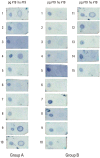Identification of immunological parameters associated with the alveolar bone level in periodontal patients
- PMID: 20498762
- PMCID: PMC2872810
- DOI: 10.5051/jpis.2010.40.2.61
Identification of immunological parameters associated with the alveolar bone level in periodontal patients
Abstract
Purpose: The present study was performed to clarify the relationship between periodontal disease severity and selected immunological parameters consisting of serum IgG titer against periodontopathogenic bacteria, the expression of the helper T-cell cytokine by gingival mononuclear cells, and patients' immunoreactivity to cross-reactive heat shock protein (HSP) epitope peptide from P. gingivalis HSP60.
Methods: Twenty-five patients with moderate periodontitis had their gingival connective tissue harvested of gingival mononuclear cells during an open flap debridement procedure and peripheral blood was drawn by venipuncture to collect serum. The mean level of interproximal alveolar bone was calculated to be used as an index for periodontal disease severity for a given patient. Each of selected immunologic parameters was subject to statistical management to seek their correlations with the severity of periodontal disease.
Results: A significant correlation could not be identified between serum IgG titers against specific bacteria (Porphyromonas gingivalis, Prevotella intermedia, Fusobacterium nucleatum, Actinobacillus actinomycetemcomitans, and Streptococcus mutans) and the severity of periodontal disease. Expression of interleukin (IL)-10 by gingival mononuclear cells was statistically significant in the group of patients who had higher levels of alveolar bone height. However, a similar correlation could not be demonstrated in cases for IL-4 or interferon-gamma. Patients' serum reactivity to cross-reactive epitope peptide showed a significant correlation with the amount of alveolar bone.
Conclusions: It was concluded that expression of IL-10 by gingival mononuclear cells and patients' sero-reactivity to the cross-reactive HSP peptide of P. gingivalis HSP60 were significantly correlated with alveolar bone height.
Keywords: Heat-shock proteins; Immunoglobulin G; T-Lymphocytes.
Conflict of interest statement
No potential conflict of interest relevant to this article was reported.
Figures


Similar articles
-
Porphyromonas gingivalis heat shock protein vaccine reduces the alveolar bone loss induced by multiple periodontopathogenic bacteria.J Periodontal Res. 2006 Feb;41(1):10-4. doi: 10.1111/j.1600-0765.2005.00832.x. J Periodontal Res. 2006. PMID: 16409250
-
Effect of periodontal treatments on serum IgG antibody titers against periodontopathic bacteria.J Clin Periodontol. 1995 Jul;22(7):510-5. doi: 10.1111/j.1600-051x.1995.tb00798.x. J Clin Periodontol. 1995. PMID: 7560233
-
Porphyromonas gingivalis, Bacteroides forsythus and other putative periodontal pathogens in subjects with and without periodontal destruction.J Clin Periodontol. 2002 Nov;29(11):1023-8. doi: 10.1034/j.1600-051x.2002.291107.x. J Clin Periodontol. 2002. PMID: 12472995
-
Cell envelope and cell wall immunization of Macaca fascicularis: effect on the progression of ligature-induced periodontitis.Oral Microbiol Immunol. 1995 Dec;10(6):321-33. doi: 10.1111/j.1399-302x.1995.tb00162.x. Oral Microbiol Immunol. 1995. PMID: 8602339
-
Modeling the relationship between clinical, microbiologic, and immunologic parameters and alveolar bone levels in an elderly population.J Periodontol. 1994 Jan;65(1):68-78. doi: 10.1902/jop.1994.65.1.68. J Periodontol. 1994. PMID: 8133417
Cited by
-
A Paradigm Gap in Host-Pathogen Interaction Studies: Lesson from the COVID-19 Pandemic.Adv Exp Med Biol. 2021;1353:47-70. doi: 10.1007/978-3-030-85113-2_3. Adv Exp Med Biol. 2021. PMID: 35137367
-
Vaccines against periodontitis: a forward-looking review.J Periodontal Implant Sci. 2010 Aug;40(4):153-63. doi: 10.5051/jpis.2010.40.4.153. Epub 2010 Aug 30. J Periodontal Implant Sci. 2010. PMID: 20827324 Free PMC article.
-
Pathological Characteristics of Periodontal Disease in Patients with Chronic Kidney Disease and Kidney Transplantation.Int J Mol Sci. 2019 Jul 11;20(14):3413. doi: 10.3390/ijms20143413. Int J Mol Sci. 2019. PMID: 31336777 Free PMC article. Review.
References
-
- Socransky SS, Haffajee AD. The nature of periodontal diseases. Ann Periodontol. 1997;2:3–10. - PubMed
-
- Ishikawa I, Nakashima K, Koseki T, Nagasawa T, Watanabe H, Arakawa S, et al. Induction of the immune response to periodontopathic bacteria and its role in the pathogenesis of periodontitis. Periodontol 2000. 1997;14:79–111. - PubMed
-
- Ebersole JL, Taubman MA. The protective nature of host responses in periodontal diseases. Periodontol 2000. 1994;5:112–141. - PubMed
LinkOut - more resources
Full Text Sources
Research Materials
Miscellaneous

